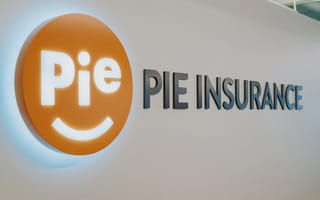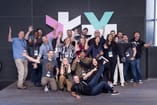Imagine a gargantuan, $1.4 trillion pie, the historic market size of the U.S. insurance industry. Then, cut that pie into 26 slices, and about one piece — 3.9 percent of the whole — represents workers’ compensation, where the top 70 carriers account for just 90 percent of that sliver.
For some companies, excelling in this fragmented environment means looking beyond the numbers and cultivating talented and loyal employees.
For instance, at Pie Insurance, an insurtech company specializing in workers’ comp insurance for small businesses, the team found a way to stay competitive and at the forefront of the industry by investing in the long-term development of its people.
According to employees — called “Pie-oneers” — a large part of their success can be attributed to their well-supported learning and organizational development program, created by two key Pie-oneers: Jen Straus, VP of people operations, and Karie Champlin-Albarrán, senior manager of L&OD.
On her first day, Straus noticed an immediate difference with previous companies where she worked. “Overall, the organization’s needs were very different, and that really determines where you go.”
To build out a learning development program, she hired Champlin-Albarrán, and together they were tasked with shaping the direction and priorities that the fledgling L&OD program needed.
For Champlin-Albarràn, the degree of freedom available to dictate the program’s form and function was important. Many organizations adopt centralized learning and development, where the department takes on requests and delivers the training itself. But that wouldn’t cut it at Pie.
“We move too fast for a reactive approach — it doesn’t address the needs,” she said earnestly. Instead, she opted to lean into the culture of learning she’d observed when she first started working at the company, leveraging the training, continuous education, and tools already in place to drive team members’ growth.
Building on top of an existing culture also meant taking into account participant feedback. Champlin-Albarrán points to this system of reciprocity — the company invests in developing its team and, in return, the team provides feedback to help improve the development function — as the basis for how she iterates and fine-tunes these programs. After all, the efficacy of L&OD ultimately depends on how much employees actually take away.
“The first thing I did was ask everyone about the challenges they’re navigating,” she explained. “We then embedded them into conversations we’re having, so I could match those challenges with the content.”
This philosophy of equipping and empowering is woven through the paths that both Straus and Champlin-Albarrán helped develop, from the Agile Thinking and Effective Communication programs, to Leader Lab, of which Business Development Manager Rob Pombar was a grateful attendee.
“Leader Lab was unbelievably helpful,” Pombar remembered clearly. “You’re in a room with like-minded leaders, knowing you’re not alone in a remote and rapidly growing business.” From there, the course took a holistic, rising-tide approach of leadership development based on conceptual elements such as compassion and observation, as well as practical role-playing to drive the point home.
Pie Insurance’s Leader Lab
Much like Pie’s business trajectory, Straus and Champlin-Albarrán’s efforts paid off in meteoric strides. Just six months after Strauss started, at a company onsite in the Denver office, she realized how much her team had done. The challenge then became how to not overwhelm the organization.
“I said to my team, tongue-in-cheek, that we don’t need to do anything the rest of the year,” she laughed. “With building infrastructure, you have to be careful. What’s our proper pace? We’re in this for the long haul.”
While Pie Insurance might not have the benefit of a centuries-long head start like its legacy competitors, its focus on talent has paid off in not just a self-sufficient and scalable L&OD pipeline, but an environment of accessible learning championed by the whole team.
For a closer look at Pie Insurance’s recipe for success, Built In sat down with Straus, Pombar and Champlin-Albarrán to see how the team baked in a culture of educational empowerment from scratch.

What goes into creating a successful L&OD program from scratch?
Straus: I didn't come from L&D, so I never had a this-is-how-it’s-done approach. And once I did start to learn, I continued to reject that. What Karie and I do is what’s best for Pie. It’s never about the way we did at our previous company and doing the same thing here. It's important to me that we're very thoughtful about where we are and what's going to work.
Champlin-Albarrán: From an empowering standpoint, we want to drive self-sufficiency. If one trainer is doing all of the teaching in the session, then that’s driving enablement, not empowerment. Empowerment is being able to access those resources after the training as well.
“If one trainer is doing all of the teaching in the session, then that’s driving enablement, not empowerment. Empowerment is being able to access those resources after the training, as well.”
With our training, we make sure that it’s flexible from a scheduling standpoint, and from a learning-retention and a habit-building standpoint, we take the blended-learning and flipped-classroom approaches. Basically, people access the content on their own on our learning management system (LMS). Then we get to live sessions, where we can focus on practice.
Because people go through independent learning on their own through our LMS, we can appeal to different learning styles and maximize the amount of time that we have together to build camaraderie. It leads back to that philosophy of equip and empower.
We also provide for scalability. Because we have the content on our LMS, anyone can access it, even outside of the actual training cohort. So it’s repeatable, and we can have multiple cohorts as we continue to scale the program.
A Cross-Section Look At L&OD
Feedback from Pie-oneers drives a lot of L&OD curation at the company. What are specific instances where a crowdsourced development led to improvements within the programming?
Straus: The first thing Karie did when she got here was go on a listening tour throughout the organization to understand what our needs are in terms of leadership development. So that input helped her build the overall plan. It was very much driven by feedback.
We also do an engagement survey that informs anything that we do on the people team in general. In addition to that survey, we did a wellness survey right after our senior manager for benefits joined. When we did that survey, we found that there were two wellness areas where people really need help: time and stress management. We needed to provide some resources on these two topics, so Karie partnered with our benefits manager to create online content.
Within six months, we saw this survey score go up by 16 points — high impact from low-level effort.
I think that it's really easy to get feedback after and change in the future, but what makes the program here different is that we get feedback before and during the process, as well. We want to make sure we’ve vetted anything that we’re rolling out.
Champlin-Albarrán: For Leader Lab, there were lots of things being tweaked as we went through based on feedback and the way conversations were going. For example, our LMS is new; we launched it in May of this year. We got a lot of feedback on the interaction with the LMS itself, as there were challenges with scrolling through the pages and making sure that all of the content was actually accessible. Based on that, I have this widget I put into every single lesson online to make sure they don’t miss content.
Pie-oneering Feedback
How much has L&OD enabled your personal and professional growth at the company?
Pombar: I went through this, so I can’t speak highly enough about the opportunity and how my career has benefited in a short amount of time. Three individuals on my team were promoted during and after my training, so it’s great being able to develop myself and hopefully position those folks to continue their career paths. In a very short amount of time, we hired eight people on the team, and I believe those people are getting way more from me as their leader than they would have if I didn’t participate in Leader Lab. I’m able to pull more out of them in a way that is empowering.
“I believe [my team is] getting way more from me as their leader than they would have if I didn’t go through Leader Lab.”
All the leaders that went through this did a 360, which is getting feedback from our people. That’s another layer — things we were trying to get out of the training sometimes emanated from the needs of our people in the team. So not only is leadership development what we want, but it is being shaped from what our people need out of us.
More importantly, we learned how to give ourselves grace and understand that, as leaders in a growing organization, we don’t have all the answers. I was sitting there, a young leader, thinking that I needed to know everything instead of just pulling that out of people in the team. We’re all just growing and learning together.











